Red eyed tree frogs are one of the most beautiful and colorful amphibians in the world.
Their typical coloration pattern in captivity includes a bright green body with darker blue sides that are mottled with vertically oriented, white patterns.
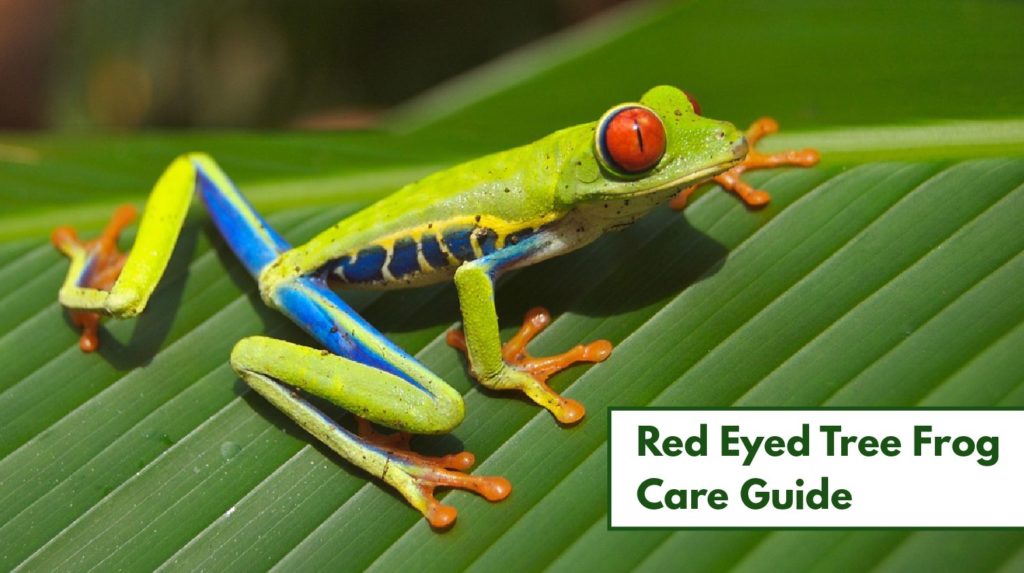
If one thing is for certain, it’s that the red eyed tree frog is a true eye catcher!
Quick Navigation
About Red Eyed Tree Frogs
The name “red eyed tree frog” is derived from their bright red (almost crimson) eyes. In the wild, these tree frog use their unique eye and body coloration patterns to scare away predators and get out of sticky situations.
As long as you’re careful and informed, red eyed tree frogs generally don’t require anything too complex when it comes to their care.
That being said, new frog owner should do everything they can to provide their frog with basic requirements – these include a suitable substrate, a drainage layer at the bottom of the terrarium, and (of course) steady portions of water and food.
Throughout this complete guide, we will cover everything you need to know about red eyed tree frog care.
By the end, you should be able to set up the perfect red eyed tree frog habitat and care for your new pet.
Natural Habitat
Red eyed tree frogs generally live in lowland rainforests that are close to some kind of water course (river, lake, etc.). As a “arboreal amphibian,” the red-eyed tree frog tends to dwell in trees and tall leafy plants.
They spend much of the tadpole stage of their life in the water, only migrating to the trees as they age and mature.
Lifespan
Provided that they’re given proper care, red eyed tree frogs usually have a captive lifespan of at least 8 years (though it is possible for some to live all the way to 12). 10 years seems to be the average life span of red eyed tree frogs.
Size
A fully grown red eyed tree frog will usually measure between 2 and 3 inches (although size may vary).
Females are generally larger than males, especially once they hit breeding age
Setting up a Red Eyed Tree Frog Habitat
There are quite a few things that you need to consider when putting together a red eyed tree frog habitat.
The most important thing to remember is that red eyed tree frogs are most comfortable when their setup closely resembles their natural environment (makes sense, right?).
This may sound tough, but we will cover everything you need to know in this section.
A few of the most important aspect to consider are tank size, temperature, materials, and substrate. Here is a more in depth look at creating a red eyed tree frog setup:
The Vivarium
Red eyed tree frogs are pretty small – as a result, people tend to cram them into enclosures that are way too small for their needs.
At minimum, one adult tree frog should be kept in a terrarium at least 15-20 gallons in size.
Since red eyed tree frogs naturally live in rain forest canopies, they prefer a habitat that has more height than width.
Our habitat of choice for red eyed tree frogs is the 18 x 18 x 24 Exo Terra Terrarium. It offers great height (which tree frogs love) and is actually large enough to house a second red eyed tree frog (in case you want to get your frog a friend in the future).
If you want to go with a cheaper option, 40 gallon breeder tanks can usually be found for pretty cheap at Petsmart (during their $1 per gallon sales) and can house 3-4 frogs.
Substrate
Choosing a substrate for your habitat is generally pretty simple.
A few of the best red eyed tree frog substrates include moist paper towels (we will discuss this later), Zoo Med Eco Earth, orchid bark, and coco coir.
A lot of red eyed tree frog owners (especially beginners) simply use moist paper towels are their substrate of choice. But why? Here are a few reasons
- Cheap: Paper towels are extremely affordable compared to other types of substrate
- Easy to clean/replace: Moist paper towels can be collected and replaces in just a few minutes
- Safe: Since there are no loose pieces, paper towels pose no impaction risk
Paper towels have one obvious downside – they definitely don’t look the best. If you’re looking for something more natural, I’d recommend going with Zoo Med Eco Earth.
This shredded coconut fiber substrate is 100% natural and helps maintain the humidity in your terrarium. Natural substrates are also preferable if you plan to keep live plants in your terrarium.
Overall, I’d recommend starting out with paper towels in your red eyed tree frog habitat (and switching to a natural substrate once you feel more comfortable).
Filling the Tank
Adding plants, branches, vines, and logs to your red eyed tree frog’s habitat is very important in helping it feel comfortable and secure.
As tree-dwelling animals, tree frogs really appreciate being able to climb throughout their enclosure.
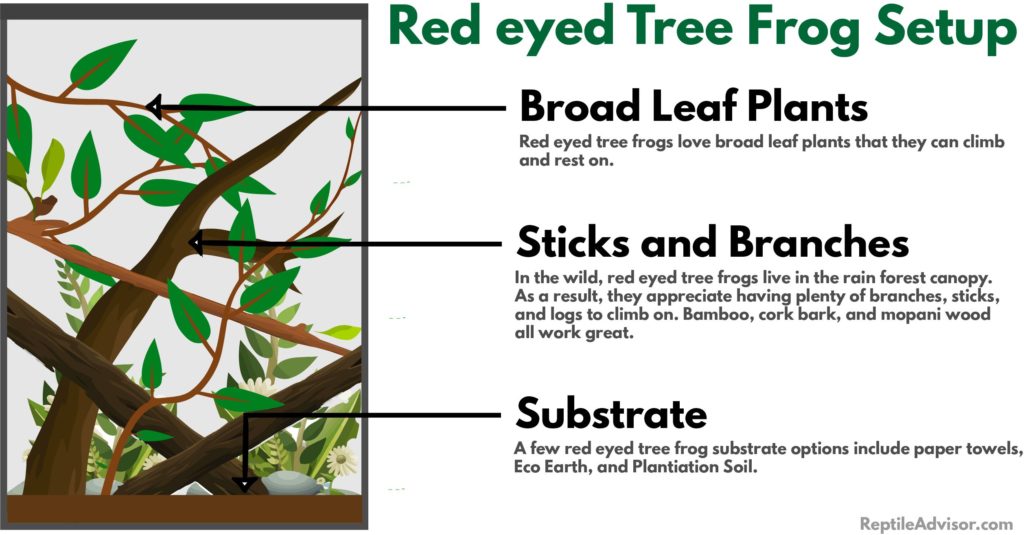
Broad leaf plants generally work best for red eyed tree frogs. Here are a few species that we recommend:
- Alocasia
- Philodendron
- Anthurium
- Birdsnest
- Chlorophytum
Keep in mind – these are live plants, so they will need some sort of light to keep them healthy.
If you would rather go with fake plants that don’t require any upkeep, Exo Terra artificial plants are pretty awesome. The Exo Terra Mardarin, Pandanus, Phyllo, are Scindapsus are personal favorites.
- Extremely realistic replicas of real plants
- Creates natural hiding spots for reptiles and amphibians
- Large, hanging plastic plant
When it comes to branches, bamboo, cork bark, and driftwood all make excellent choices (either real or fake) for your frog to climb on.
When placing the branches, make sure they’re relatively high up in the enclosure so that your tree frog feels as though it’s climbing (as it might in its natural habitat).
Make sure the branches are secure so that your frog won’t fall mid-climb!
Artificial vines are another awesome addition – you can hand these around your vivarium to create an tropical oasis for your frog!
Red Eyed Tree Frog Diet and Hydration
Feeding you tree frog the proper types of food is extremely important for long term health.
Unfortunately, it can be a bit more complicated than just throwing in a few crickets every now and then.
Here is everything you need to know about red eyed tree frog diet, hydration, and supplementation:
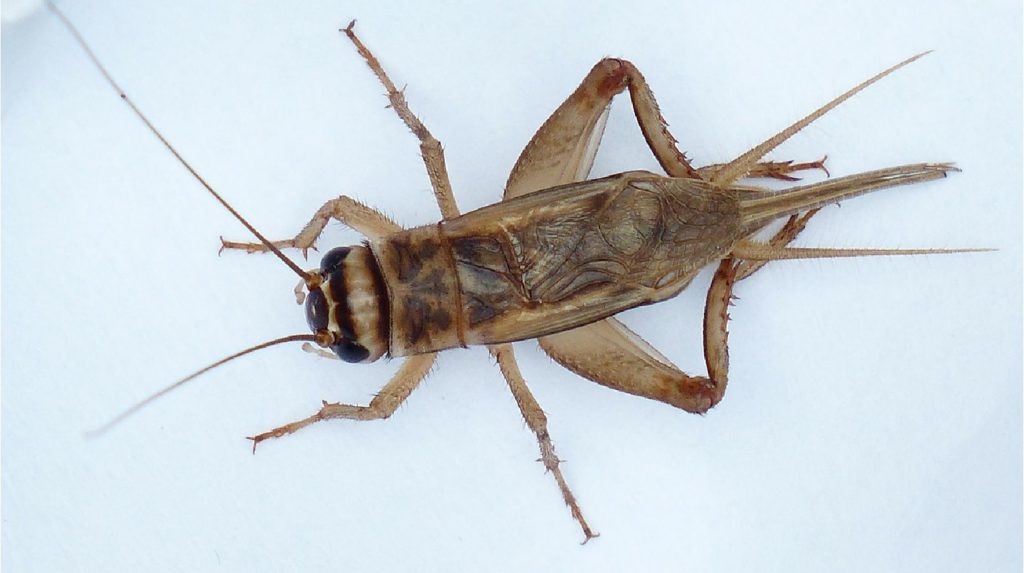
Insects
Insects make up the vast majority of the red eyed tree frog’s diet. Here are a few types of insect that work well for regular feeders:
- Crickets (main staple)
- Silkworms (occasionally)
- Hornworms (occasionally)
- Dubia Roaches (occasionally)
Crickets will most likely be the main staple for your red eyed tree frog. They are cheap, readily available, and suitable for tree frogs of all ages. Feed each frog 3-6 crickets every 2-3 days.
It is very important that you “gut-load” your crickets about 24 hours before feeding them to your tree frogs.
Gut-loading refers to the practice of feeding your crickets beneficial foods before they are eaten by your frogs.
But what exactly should your crickets be munching down on?
It is recommended that you feed your crickets a mixture of fresh salad, carrots, veggies, and some sort of Vitamin D3 or calcium supplement (we will discuss this soon with our recommendation).
Red eyed tree frogs generally don’t touch greens by themselves – so feeding the crickets greens before they’re eaten by your frog is a great way to introduce nutrients to your frog’s diet.
Diet Supplementation
Supplementing your red eyed tree frog’s diet with Vitamin D3, calcium, and multivitamin supplements is a great way to keep your pet healthy.
We recommend supplementing your tree frog’s diet with a mix of Repashy Calcium Plus, Repti Cal with D3, and Rep-Cal Herptivite.
One way of getting supplements into your frog’s diet is by dusting its crickets.
Before feeding time, give your crickets a light mist with a spray gun. Next, place them in small plastic/paper bag and sprinkle some calcium powder on top. Shake the bag around (gently) until the crickets look adequately coated.
Another way of introducing calcium into your frog’s diet is by gut-loading crickets with the calcium/multivitamin powder.
Simply sprinkle some power on whatever you decide to feed your crickets (veggies, salad, etc) and then feed them to your frog.
Here is a sample feeding schedule for your red eyed tree frog:
- Crickets dusted with Herptivite – one time per week
- Crickets dusted with calcium/D3 – one time per week
- Plain crickets without any dusting: one time per week
For juvenile tree frogs, we recommend that you dust their insects at every feeding – they need all the nutrients they can get!
Hydration
Tree frogs stay hydrated by drinking and absorbing moisture through their skin. The best way to keep your frog hydrated is by keeping a large, shallow water dish in their habitat. The dish should be wide enough that your frog can fit inside comfortably.
In addition, the water should be shallow enough that your tree frog can rest inside comfortably without having to swim.
A good rule of thumb is that the water should be no higher than the frog’s mouth when resting.
The water dish should be washed and refilled on a daily basis.
It is also very important that you only use dechlorinated water in your tree frog habitat – both for the water bowl and for mistings.
Tap water should be avoided as it often contains chlorine and other chemicals that are bad for tree frogs. A gallon jug of bottled water will go a long way.
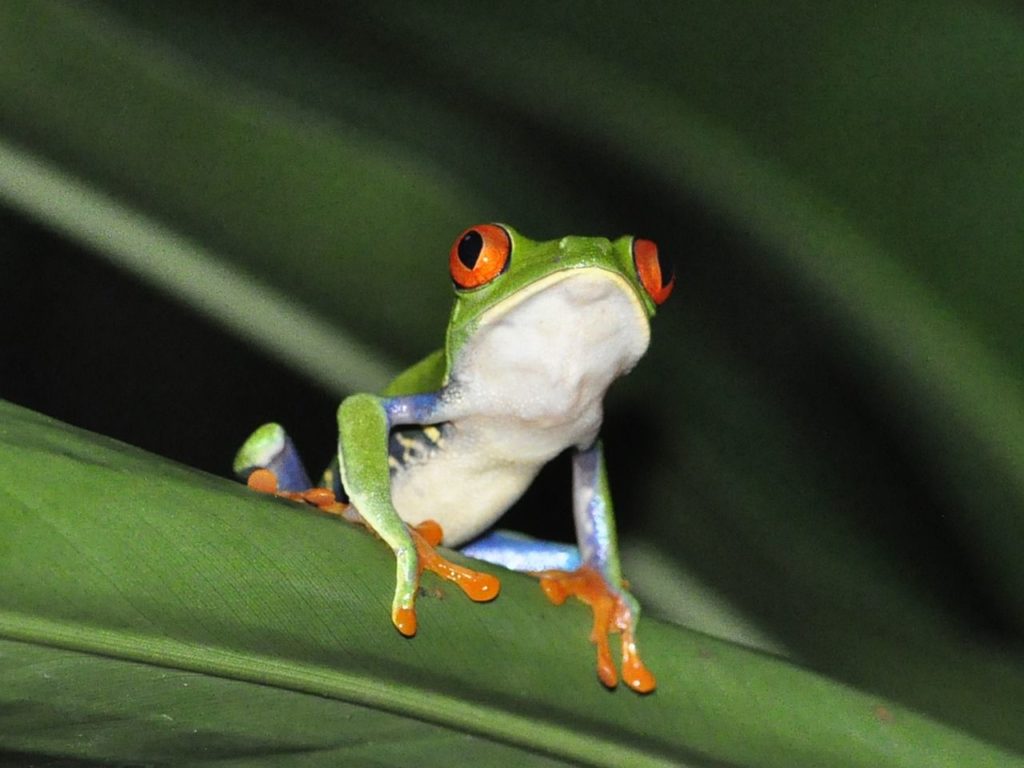
Lighting and Heating
When setting up a read eyed tree frog habitat, you’ll want top make sure you don’t forget the lighting and heating elements. These are important to recreate the light and warmth they would experience in their native rainforests.
Here is everything you’ll need to know about red eyed tree frog lighting and heating
Red Eyed Tree Frog Lighting
A lot of red eyed tree frog owners have recently started advocating the use of UVB bulbs in their frog enclosures.
UVB is important for tree frogs because it helps with the synthesis of Vitamin D3 (with is responsible for calcium absorption). Without UVB light, tree frogs are susceptible to Metabolic Bone Disease.
The best UVB light for red eyes tree frogs is the Zoo Med ReptiSun 5.0 T5. Tree frogs don’t need a ton of UVB light, so even a small bulb should work just fine. Also, make sure to provide them with a lot of shade.
- Stronger UVB and brighter light than standard ReptiSun 5.0 lamps
- Increased UVB Output, perfect for larger reptile habitats
- Helps prevent or reverse metabolic bone disease commonly seen in captive reptiles
In addition to a UVB bulb, you’ll also want to add some sort of “heat” lamp to one side of the terrarium for additional warmth (I say “heat” because red eyed tree frogs really don’t like it too warm or bright).
A 6500K LED bulb is perfect for red eyed tree frogs and will also help a ton if you plan to keep live plants.
If the ambient temperature in you red eyed tree frog’s enclosure fall below the optimal levels which we will discuss in the next section), you may want to invest in a ceramic heat emitter.
CHEs heat your tank without the use of any visible light, so they’re perfect for daytime and nighttime use alike (since they don’t upset your frog’s sleeping patterns). The Fluker’s Ceramic Heat Emitter is a perfect option.
Temperature Requirements
Digital thermometers are recommended for accurate temperature readings (since dial thermometers tend to be pretty inaccurate.
A 2-in-1 thermometer/hygrometer is a great all in one solution to take care of humidity and temperature readings together.
During daytime hours, ambient temperatures should site somewhere between 75 and 80 degrees Fahrenheit.
Slightly cooler nighttime temperatures are fine as long as it doesn’t fall below 70 degrees. If night time temperates fall below 70°F, invest in a ceramic heat emitter (as we discussed in the lighting section).
Humidity
Humidity is especially important for red eyed tree frogs. Native to rainforests throughout Central America, humidity is essential for their health and comfort.
It is also important to ensure that the humidity of your tank stays within the desired range. In this section we will talk about what humidity levels you should aim for and how to achieve these.
Humidity Requirements
An important part of perfecting your red eyed tree frog habitat is knowing how to read humidity levels. Luckily, this can be easily done with a digital hygrometer. Stay away from dial hygrometers as they tend to be very inaccurate.
The optimal red eyed tree frog humidity level should sit anywhere between 70-80%. The best way to raise the humidity level in your setup is through simply mistings. Mist the tank twice a day with purified water until humidity levels reach the desired percentage.
Make sure to mist all of the enclosure’s decorations and branches, as red eyed tree frogs get most of their water by licking foliage and sticks.
Controlling your tanks humidity
Mistings should take place twice per day – once in the morning and once in the afternoon. For larger tanks, you might need to mist another few times throughout the day.
This can be done with a simple spray bottle, although there are also more advanced fogging systems on the market. If you decide to use a spray bottle, make sure that it is brand new and was never used for any cleaning solutions.
Once again, only mist your red eyed tree frog setup with purified bottled water. If you want to go a more advanced route, the Exo Terra Monsoon RS400 Rainfall System is a great option.
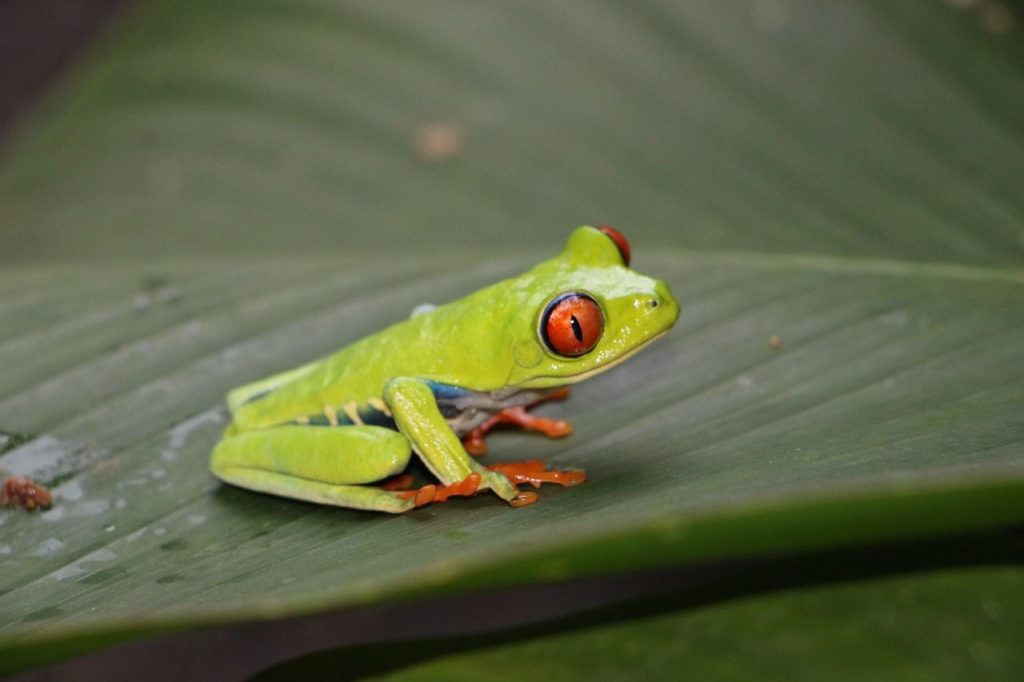
Tips and Tricks
Here are a few important tips and tricks regarding red eyed tree frog care:
Keeping your tank clean
Cleaning your red eyed tree frog setup on a regular basis is very important. Any waste that gathers on the bottoms should be removed as soon as possible.
Mold tends to grow quickly in humid environments, so wiping down your tree frog’s enclosure will really help keep it safe.
If you’re using a natural substrate (such as Zoo Med Eco Earth), it will most likely need to be replaced every few months.
Once again, watch closely for any mold growth, especially in substrates.
If you’re using any rocks in your terrarium, remove them occasionally for a good cleaning. Rocks and branches can be baked at 350°F for sterilization purposes.
One of the leading causes of death in red eyed tree frogs is something called “Red Leg Disease”, which occurs mostly from unsanitary habitat conditions.
As you can see, cleaning your frog’s habitat is not just for aesthetic reasons – it is also crucial to the safety of your pet.
Safe Feeding Practices
Adult red eyed tree frogs are perfectly fine eating full sized crickets. That being said, babies will most likely need smaller crickets for safe feeding. Crickets under 1/4 inch long should work well.
A general rule for sizing crickets is that they should be no wider than the distance between your frog’s eyes.
Handling
Unsurprisingly, red eyed tree frogs are not huge fans of being handles – most frogs aren’t.
While they can be handled without problem for a few minutes, red eyed tree frogs are too delicate to be handled regularly or for long periods of time. If you want something that you can hold/play with all the time, tree frogs may not be for you.
If you do decide to hold your frog, make sure you thoroughly rinse your hands before contact.
Tree frogs can absorb toxins and other harmful substances through their skin, so make sure your hand are clean as can be.
Other Resources
If you suspect that your frog is sick (or have any specific care questions), take him/her to the vet.
Although we do our best to help out all frog owners, sometimes specialized care is needed. Good luck with your new red eyed tree frog!
Last update on 2024-07-26 / Affiliate links / Images from Amazon Product Advertising API


Thanks for all the useful information. I’m interested in purchasing and setting up a habitat for a red-eyed tree frog and I’m doing a lot of research first. One question I have, that I don’t see here is, do they do ok by themselves or should I purchase 2 frogs to keep each other company? Thanks in advance!
Hi Carol! Although you can keep a single frog by itself, we recommend housing 2-3 frogs per enclosure. Tree frogs are pretty social and love to interact with each other!